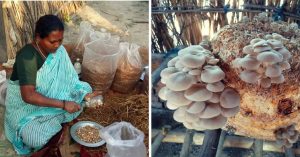TBI Blogs: Here’s How You Can Help India’s Poor Survive the Bitter Cold in the Heart of Winter
Winters in many parts of India can be very harsh, especially for villagers and the urban poor who don’t have access to woolen clothing or cover. A campaign hopes to offer solutions for this annual problem.
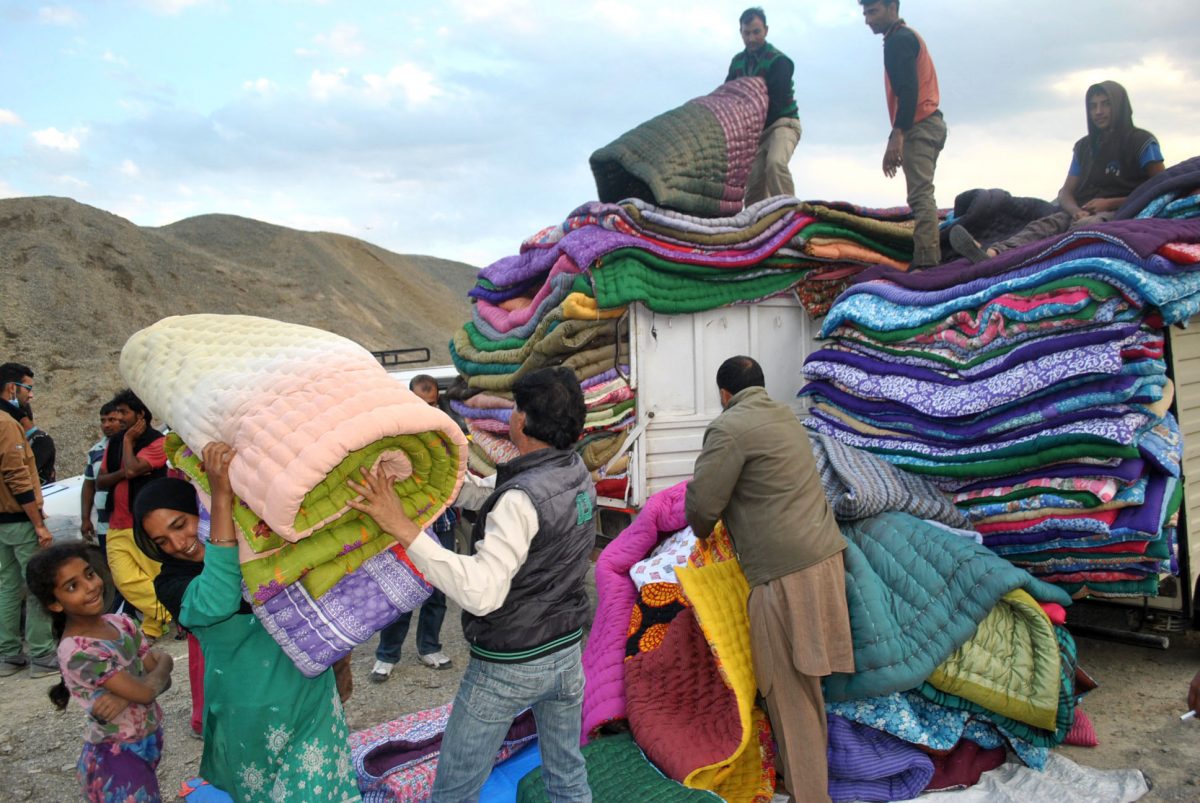
Winters in many parts of India can be very harsh, especially for villagers and the urban poor who don’t have access to woolen clothing or cover. A campaign hopes to offer solutions for this annual problem.
Many years ago, outside the LNJP hospital in Delhi, 6-year-old Bano hugged a dead body to deal with the cold. Some of you may have heard or read about Bano and her father Habib Bhai. So why are we telling you her story again, over two decades after the incident? Probably because it’s still relevant today.
Anshu Gupta, Founder, Goonj had just finished his journalism studies when he met Habib Bhai. Like any enthusiastic young journalist, Anshu roamed around the Delhi roads, looking for a story. That’s when he saw a rickshaw with a strange line written on its back, “lawaris laash uthane wala” (“unclaimed dead body transporter”). That rickshaw belonged to Habib Bhai, who lived on a pavement outside LNJP hospital in Delhi. He picked up abandoned dead bodies for the Delhi police. Anshu spent a week with Habib Bhai trying to understand the intricacies of this strange profession.
That’s when Bano innocently told Anshu, “When I feel cold, I hug the dead body and sleep. It does not trouble me, as it does not turn around.”

If you are out at night in any city of North India, we hope you are wrapped up in a layer of warm clothes, because it’s starting to get cold out there right now. In the coming weeks, when it will get really cold, some unfortunate people might die on the roads. They likely will not have any woolen clothes on their body as they struggle through the chilly and windy nights out in the open.
Government statistics reveal that winters are the second major reason for deaths in India, after lightning. Floods come third on this list. Statistics show that till 2007, 826 people died every year due to harsh winters in India. The death toll started to increase after 2007 due to a drop in winter temperatures. Between 2002 and 2012, as many as 10,740 people died from exposure to cold and avalanche. Clearly, hundreds of winter deaths are considered “normal”, and there is hardly any effort to find the exact reason behind them.
Habib Bhai said to Anshu, “In winters, my work goes up. Sometimes there is so much work that I find it difficult to handle.” In a radius of 5-6 km., where Habib Bhai could take his rickshaw, in winters, he would pick up 11-12 dead bodies daily (on average), whereas in summers, the number dwindled to almost half. A possible conclusion is that it’s not the cold that kills people, but the lack of clothing.
Apart from being the first visible sign of poverty, lack of clothing is also the reason people succumb to the cold wave.
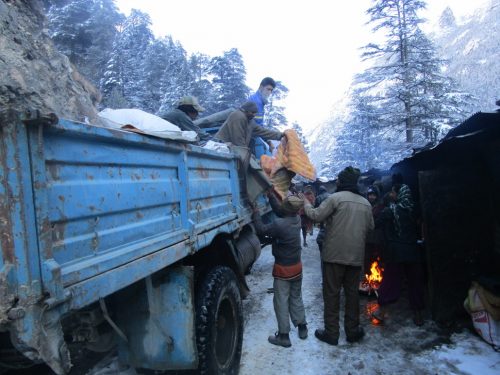
In 2009-2010, Goonj’s partner organization Prayas Shiksha Samiti (from Mandla, Madhya Pradesh) mentioned frequent accidents happening in their area due to fire in winters. Mandla is a poverty-stricken tribal land where people often don’t even have enough to eat. Clothing was, therefore, a secondary need they struggled with.
Typically, households would fill a sack with dried grass/husk and sleep in it, lighting a fire right next to it. Some years ago, in the heart of winter, Hare Singh, a local villager, went off to sleep in the open courtyard of his home, with a fire lit next to him. Around midnight, the entire hut caught on fire. The villagers managed to save Hare Singh’s life, but the burns left him disabled for life. In the harsh winters of 2010, Narbad Das (from the village Sinjhora in district Mandla) died while sleeping outside his hut, overseeing his crop. There are many Hare Singhs and Narbad Das-s in rural India, who put their lives in danger, or remain awake the whole night next to the alaav (community fireplace) and go to sleep only in the morning, at the cost of their income and livelihood.
These deaths are rarely reported and accounted for.
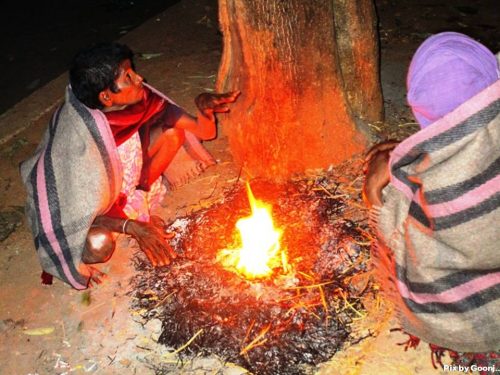
People aren’t struggling just in Madhya Pradesh. The same is true for many in Uttarakhand, Bihar, Jammu & Kashmir, Uttar Pradesh, Chhattisgarh, and Jharkhand as well. For over 18 years, Goonj has highlighted winters as an annual preventable disaster and constantly worked on it under the ‘Rahat Winters’ campaign, now called ‘Odha Do Zindagi’. This is why it is asking people living in the warm comforts of city homes to donate their woolens and blankets.
The campaign collects urban under-utilized woolens, clothes, and other basics from the cities, and after a rigorous process of value addition, reaches rural India as ‘winter kits’. Each winter kit – comprising of clothes, woolens, sujnis/blankets, etc. is meant for one family’s needs. The interesting bit is that people in villages don’t receive these kits as charity. Instead, they take up work on wide-ranging community development issues and then get these kits as a reward for their efforts. In the process, the community also becomes cloth-rich.
Charan Parte, (a resident of Keolari Kala village from Block Mawai, Mandla, MP, where Goonj has been working) says, “Every year we had to spend Rs. 2,000- 3,000 on clothing for all the family members, and given our financial condition, we used to take the money on high-interest loans. But, for the last few years, I do not remember having spent anything on clothing. Now we have enough.” Uttara Padwar, from Prayas Shiksha Samiti informs that the incidences of people dying in the cold have dropped significantly.
Winter Kits – in big numbers – have reached many parts of India like Uttarakhand, the J&K border areas, Bihar, and parts of central India where winters are quite severe.

Among the many roles that cloth and woolens play in lives, some are really surprising. On an impact assessment visit to the Khandwa region of Madhya Pradesh, Goonj found that woolens provided by it were a big boon to malnourished children admitted to hospitals. When woolens and blankets reached many villages in the region, the villagers were able to save Rs. 1,000-1,200 per family. Earlier they had to pay heavy interest on the loan they would take to buy woolens and clothes. The savings helped them spend more on food.
In many villages, since electricity usually comes only at night, the farmers were forced to stay in the fields to water their crop through the chilly winter nights. Without enough clothes, this was a daily struggle, where woolens turned into a life saver. In many villages like Booti, located around 80 kms. from Khandwa in the middle of a jungle, woolens aren’t even available. Providing woolens to these villagers has afforded them the possibility of wearing warm clothing during winters.
A Sujni/kantha/godra (the traditional quilt) – sewn together out of layers of big cloth pieces – is one of the key things that goes into a Goonj winter kit. This is special because it’s useful round the year—as a blanket in winters and a mattress in summers. An added advantage is that this humble blanket of the poor is creating sustained income for hundreds of women. In the last two years alone, women at Goonj’s Rishikesh and Uttarkashi centers created over 37,000 sujnis out of absolute waste.
Last winter, Goonj could deliver 10,660 Winter Kits to Guptakashi in Uttarakhand, covering over 100 villages, apart from 2,988 labor kits for migrant labourers, and over 7,500 kits and 3,500 labour kits to Uttarkashi.
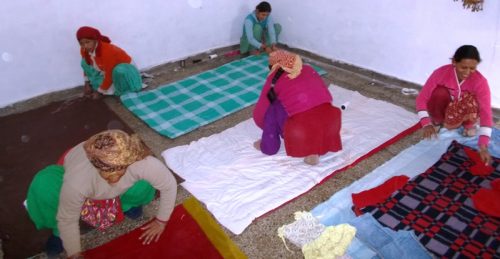
While Goonj is doing its bit to provide woolens and clothes to most far-flung villages, and the villagers are working hard on difficult issues to earn these, we hope you, living in the cities, and the crucial link in this chain, also play your role in donating your unused woolen coats, blankets, socks, mufflers, and caps to save someone’s life. This – in the true sense – exemplifies collective responsibility for addressing an issue.
Join Goonj’s efforts to spread warmth to more people. You can also support the campaign monetarily. Contact Goonj for more information.
Like this story? Or have something to share? Write to us: [email protected], or connect with us on Facebook and Twitter.
NEW: Click here to get positive news on WhatsApp!
This story made me
-
97
-
121
-
89
-
167
Tell Us More
If you found our story insightful, informative, or even just enjoyable, we invite you to consider making a voluntary payment to support the work we do at The Better India. Your contribution helps us continue producing quality content that educates, inspires, and drives positive change.
Choose one of the payment options below for your contribution-
By paying for the stories you value, you directly contribute to sustaining our efforts focused on making a difference in the world. Together, let's ensure that impactful stories continue to be told and shared, enriching lives and communities alike.
Thank you for your support. Here are some frequently asked questions you might find helpful to know why you are contributing?






